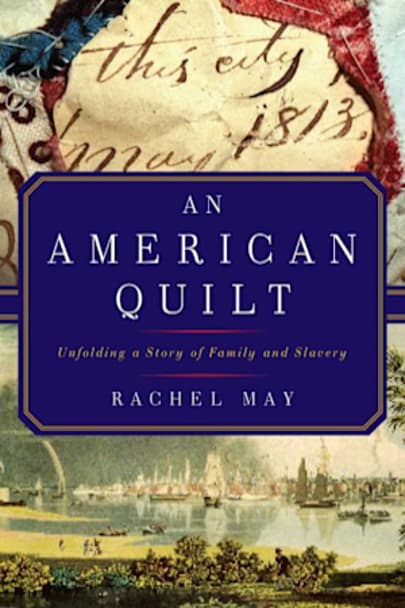Rachel May’s rich new book explores the far reach of slavery, from New England to the Caribbean, the role it played in the growth of mercantile America, and the bonds between the agrarian south and the industrial north in the antebellum era–all through the discovery of a remarkable quilt. While studying objects in a textile collection, May opened a veritable treasure-trove: a carefully folded, … folded, unfinished quilt made of 1830sera fabrics, its backing containing fragile, aged papers with the dates 1798, 1808, and 1813, the words “shuger,” “rum,” “casks,” and “West Indies,” repeated over and over, along with “friendship,” “kindness,” “government,” and “incident.” The quilt top sent her on a journey to piece together the story of Minerva, Eliza, Jane, and Juba–the enslaved women behind the quilt–and their owner, Susan Crouch. May brilliantly stitches together the often-silenced legacy of slavery by revealing the lives of these urban enslaved women and their world. Beautifully written and richly imagined, An American Quilt is a luminous historical examination and an appreciation of a craft that provides such a tactile connection to the past.
more



Rachel May, an Assistant Professor at Northern Michigan University, was shown an 1830s hexagon quilt top with backing papers that revealed a glimpse into its history. In ornate handwriting were the dates 1798 and 1813 and the words rum, casks, West Indies, shuger.
Fascinated by this quilt, May, a quiltmaker and author of Quilting with a Modern Slant, researched the quilt’s heritage and historical background. It took her on a six-year journey deep into a history we have conveniently forgotten, the economic roots of New England wealth based on the slave trade and slave labor.
Family letters and genealogical research helped May create an understanding of the Crouch-Williams-Cushman family behind the quilt, raising questions about racism throughout American history.
The makers of the quilt top were Susan McPherson Sibley Williams (1813-1902), whose mother rented a room to Brown University medical student Hasell Wilkinson Crouch (1809-1836). Susan married Hasell and they moved to Hasell’s native Charleston, South Carolina. The couple worked on the hexagons together. One hundred years later, Susan’s grandnephew Franklin discovered the top. He created a notebook with sample fabrics, some noted as “probably for slave gowns,” and transcribed the family letters.
friendship sloop schooner invest fame dear sister maintained Havana Barbados barrels seaman Carolyna Newport government incident kindness
Hexagon pieces, mostly19th c reproduction fabrics, which I used in my Charles Dickens quilt
Susan’s two brothers went South to begin their careers. One brother became committed to the Confederate cause, defending the economic advantage, and luxurious life, based on an enslaved labor force. Wasn’t the North an abolitionist mecca? How could Susan not have seen the human suffering behind the “servants” who cared for her family’s needs? How did a Rhode Island family, transplanted to the South, so readily adapt to the role of slave owners?
What shocked May was the realization that the North was complicit with slavery.
I remembered the song Molasses to Run to Slaves from the musical 1776 which we had seen performed live in Philadelphia during the Bicentennial. It was my first understanding of the Triangular Trade.
Who sails the ships out of Guinea
Ladened with bibles and slaves?
‘Tis Boston can boast to the West Indies coast
Jamaica, we brung what ye craves
Antigua, Barbados, we brung bibles and slaves!
Molasses to rum to slaves
Who sail the ships back to Boston
Ladened with gold, see it gleam
Whose fortunes are made in the triangle trade
Hail slavery, the New England dream
With the names of the enslaved women–Minerva, Eliza, Jane, and Juba–and references in letters and historical documents, May imagines their lives. She traveled across the country to understand the world they lived in, visiting historic sites and forgotten places. It was an emotional journey, soul-wracking. Throughout the book, she mixes a deep understanding of American history with her research to construct fictionalized stories of the woman’s probable lives.
In the end, May concludes that we each must decide how to live in a country built on genocide, enslavement, land theft, and racism. She urges us to consider how we participate in injustice today. What stories should we be telling? What choices should we make to not support modern businesses built on enslaved labor and modern indentured servants working in horrific conditions? How do we respond to human trafficking today?
An American Quilt is more than the story of a quilt or genealogy research on a family or even a recreation of the lives of enslaved persons. May questions the foundations of our heritage, the misconceptions we hold and challenges us to reevaluate how we today participate in supporting unjust economic systems.
I received a free ebook from the publisher through Edelweiss in exchange for a fair and unbiased review.